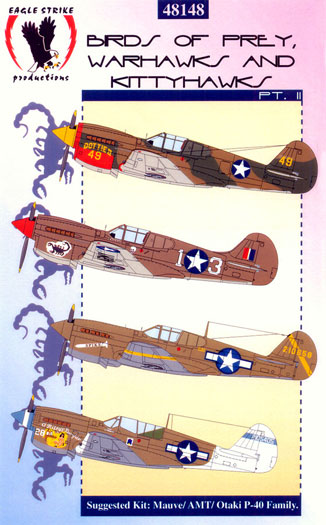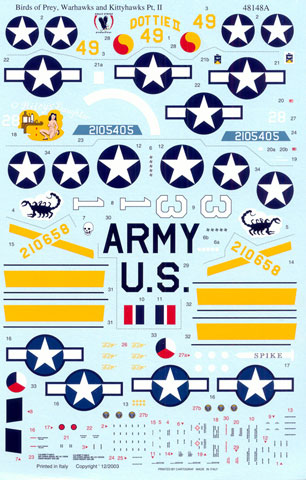|
 Birds
of Prey Birds
of Prey
Warhawks & Kittyhawks
Pt.2
1/48 scale
Eagle Strike
Decals
|
|
|
S u m m a r y
|
| Catalogue
Number: |
Eagle Strike 48-148 - Birds
of Prey Warhawks & Kittyhawks Pt.2 |
| Scale: |
1/48 |
| Contents and Media: |
Waterslide decals plus
separate stencil sheet - Decal
sheet plus instructions and notes |
| Price: |
MSRP USD$10
available from Aeromaster's website |
| Review Type: |
FirstLook |
| Advantages: |
Colourful markings; all
markings supplied including stencils (two sets of stencils); perfect register; thin;
minimal carrier film; |
| Disadvantages: |
|
| Recommendation: |
Recommended |
Reviewed
by Rodger Kelly

Eagle
Strike's 1/48 scale Birds of Prey Pt. 2 are available
online from Squadron.com
Eagle Strike 48-148 is the second of two new sheets
covering the Curtiss P-40 family.
Part two also provides full markings for four
machines but this time, each option is a different mark of the P-40.
The individual aircraft are as follows.
 P-40E
'DOTTIE II" of the 8th Fighter Squadron, 49th Fighter Group based at
Dobodura, New Guinea in April of 1944. The machine is in the U.S.
equivalents of RAF dark green, dark earth and sky grey. The spinner is
yellow and the forward and lower portions of the engine cowling and
forward fuselage are red. The use of red paint also extends to the
undercarriage fairing. The supplied markings comprise: P-40E
'DOTTIE II" of the 8th Fighter Squadron, 49th Fighter Group based at
Dobodura, New Guinea in April of 1944. The machine is in the U.S.
equivalents of RAF dark green, dark earth and sky grey. The spinner is
yellow and the forward and lower portions of the engine cowling and
forward fuselage are red. The use of red paint also extends to the
undercarriage fairing. The supplied markings comprise:
-
The name "DOTTIE II" in yellow
-
49
plane-in-squadron number in yellow for the cowling and the fin.
-
Red and yellow "ying
and yang " designs for the wheel covers
- A complete set of national
insignia.
P-40K-1 of the 64th Fighter
Squadron, 57th Fighter Group at Hani main, Tunisia in May of 1942. The
aircraft is in sand upper surfaces with neutral grey under surfaces a
sports a red spinner. The supplied markings comprise:
-
White (with a thin
black outline) 13 plane-in-squadron number for the fuselage
-
Nose art (both
sides) comprised of a black scorpion on a white background
-
"Kill" markings
consisting of five swastikas on white circle backgrounds. This
marking is a two-part decal with the swastikas being applied over
the top of the white circles.
-
Further artwork of
a white skull for the left fuselage side
-
U.S. ARMY titles
for the lower surfaces of the wings
-
Red, white and
blue fin flashes
-
A full set of
national insignia
P-40L 42-10658 "SPIKE" flown by
Colonel W. Moyer, the Commanding Officer of the 33rd Fighter Group,
Peastrum, Italy in 1943. The machine is in olive drab upper surfaces
and neutral grey lower surfaces. The supplied markings comprise:
-
Nose art
consisting of the silhouette of a white nail with the word "SPIKE'
in black for the left hand side of the nose
-
The serial number
in yellow for the fin and rudder. This decal also incorporates a
yellow diagonal stripe
-
A set of yellow
theatre bands for the wings. There are also a set of separate thin
black bands supplied for this option. No mention is made of them on
the placement guide but my bet is that they are for the edges of the
theatre bands
-
"Kill" markings
comprising of eight yellow Swastikas
-
Red, white and
blue segmented markings for the wheel covers
-
A complete set of
faded national insignia
-
The data block stencil
P-40N-5CU 42-105405 "O'Riley's
Daughter" flown by First Lieutenant Jack A. Fenimore of the 7th Fighter
Squadron, 49th Fighter Group. The machine is finished in olive drab
over neutral. The spinner is medium blue with a white stripe. The use
of blue extends to the lip to the intake cowling and a stripe across the
fin and rudder. It also wears white empennage and wing leading
edge theatre markings. The supplied markings comprise:
-
The white stripe for the spinner
-
Nose art consisting of a naked woman
and a bar with three liquor bottles and a glass on a yellow
background with the words "O'Riley's Daughter" in
white
-
White 28 plane-in-squadron number for
the nose
-
7th Fighter Squadron shield for the
left hand side of the fuselage beneath the cockpit. Three separate
decals are supplied for this marking. The first one is an one-piece
decal that incorporates the shield and a white rectangular
background whilst the second one has a separate white background to
avoid any register problems (none on my sample)
-
The blue stripe for the fin and
rudder. Unfortunately, this stripe incorporates the serial number
which means that you will have to mix your paint to match this decal
when you paint the spinner and intake lips
-
A single Japanese rising sun flag
"kill" marking. Again, this is supplied as a single marking as well
as two separate decals to avoid register problems
-
Pilot's name in white for the
fuselage side beneath the windscreen
-
A full set of national insignia.
-
The data block stencil
The sheet also includes two comprehensive sets of
stencil data.
The placement guide is the industry standard A-4
sized sheet and it shows left hand side colour profiles of each option
on the front and smaller upper and lower surface plan views of each
option on the back. There is also a four-view line drawing of a P-40N
showing placement of the stencil data. As with Part 1, the placement
guide carries a short discourse on the likely colours worn by these
machines and refers the modeller to the book "Sam's Combat Colors #3" by
H.C. Bridgewater for a fuller explanation.
The decals themselves have been "printed in
Italy". Everything is sharp and clear and in perfect register with an
absolute minimum of film surrounding each design.
The decal sheet and placement guide come packed in
a clear plastic zip-loc bag.
Again, this is an excellent sheet as far as I'm
concerned. It is value for money as it provides full markings for four
different machines in a variety of finishes.
Recommended.
Thanks to AeroMaster
/ Eagle Strike
Products for the review sets
On-line sales are available from the
AeroMaster Products /
Eagle Strike Productions web site.
Review Text and Images Copyright © 2004 by
Rodger Kelly
This Page Created on 25 October, 2004
Last updated
26 October, 2004
Back to
HyperScale Main Page |
Home | What's
New | Features
| Gallery |
Reviews | Reference
| Forum
| Search